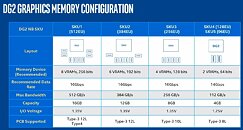
Intel Patch Notes Reveal Arc A750E & A580E SKUs
Phoronix has taken a short break away from monitoring the latest goings-on at AMD's software department—the site's editor-in-chief, Michael Larabel, took a moment to investigate patch notes relating to Intel's Xe and i915 Linux kernel graphics drivers. Earlier today, he noticed that "two additional PCI IDs" have been added to Team Blue's DG2/Alchemist family. This discovery prompted further sleuthing—after: "some searching and turning up hits within the Intel Compute Runtime code, 0x56BE is for an Intel Arc Graphics A750E variant and 0x56BF is for an Intel Arc Graphics A580E."
The aforementioned GPU identification codes seem to exist in gray area—the patch notes do not reveal whether these new variants are destined for desktop or mobile platforms. VideoCardz cited a remark made by "Bionic_Squash"—the reputable leaker reckons that the: "IDs are linked to Intel's Arc Embedded series. This family is tailored for industrial, business, and commercial applications, ranging from edge systems to powering large interactive screens." It is highly likely that Intel is paving the way for embedded/low-power variants of its existing Arc A750 and A580 GPUs. Tom's Hardware proposes that Team Blue is clearing out its inventory of remaining Alchemist silicon ahead of a successive generation's rollout—Battlemage is a major priority in 2024.
The aforementioned GPU identification codes seem to exist in gray area—the patch notes do not reveal whether these new variants are destined for desktop or mobile platforms. VideoCardz cited a remark made by "Bionic_Squash"—the reputable leaker reckons that the: "IDs are linked to Intel's Arc Embedded series. This family is tailored for industrial, business, and commercial applications, ranging from edge systems to powering large interactive screens." It is highly likely that Intel is paving the way for embedded/low-power variants of its existing Arc A750 and A580 GPUs. Tom's Hardware proposes that Team Blue is clearing out its inventory of remaining Alchemist silicon ahead of a successive generation's rollout—Battlemage is a major priority in 2024.























































